Does salt belong in tea? While an American scientist claims a pinch is the secret to the perfect cup of tea, MailOnline tests her unusual method – with surprising results
It may sound like a cruel joke, but a pinch of salt can be the secret to the perfect cup of tea.
So says Dr. Michelle Francl, an American chemist, who claims to have found the secret of the perfect brew.
Her unusual recipe has caused a stir by adding hot milk and a pinch of salt.
Dr. Francl may think she knows best, but how does this recipe compare to the classic British cuppa?
MailOnline’s Wiliam Hunter has put her recipe to the test, with some surprising results.
It may sound like a cruel joke, but a pinch of salt can be the secret to the perfect cup of tea
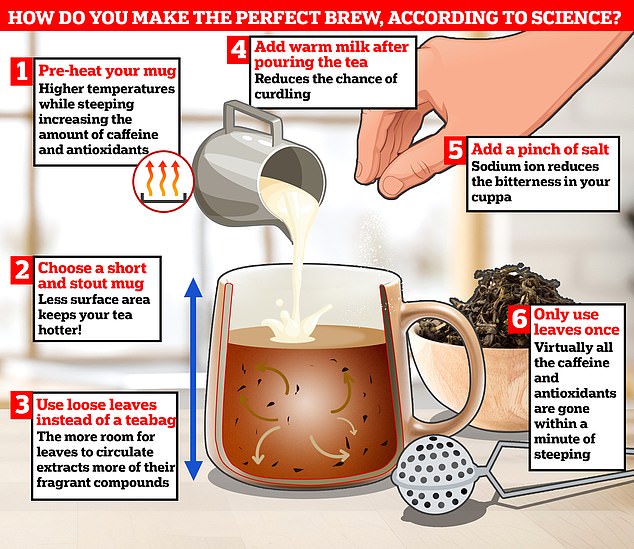
Dr. Michelle Francl, an American chemist, claims to have found the secret of the perfect brew. Her unusual recipe has caused a stir by adding hot milk and a pinch of salt
Normally, making a cup of tea is about as simple as it gets.
But the search for the perfect tea break requires a few extra steps, according to Dr. Francl.
First, she recommends preheating your mug before even looking at a tea bag.
She claims this will help the cup stay warm longer during steeping, which in theory will increase the amount of caffeine and antioxidants in the cup.
I heated the mug by adding some hot water to it for a few minutes before pouring it away.
Dr. Francl advocates loose-leaf tea that can offer a more complex and natural flavor.
However, working within the constraints of MailOnline’s kitchen, I opted for Tetley’s English Breakfast instead.
The tea was then allowed to steep for three minutes, which is the ideal brewing time according to the box it came in.
But there were still a few steps to go through before I could relax with my well-deserved cup of tea.
People may wonder whether you should add the cold milk before or after the tea, but this recipe takes it a step further.
Dr. Francl asks for hot milk to be added after the tea is brewed, so I microwaved a mug of milk briefly before adding it to the tea.
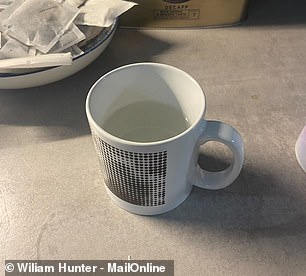
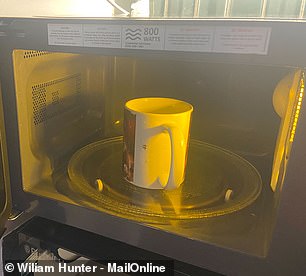
In search of the perfect cup of tea, we started by preheating our mug (left) by filling it with boiling water and microwaving some milk (right) to make sure it was nice and warm.
But in addition to being very messy to pour from one mug to another, the heated milk gave the tea a somewhat unappealing appearance.
Heating the milk is intended to prevent curdling, which can occasionally happen when cold milk is mixed with hot tea.
But when I tried this, the tea took on an almost waxy, slightly frothy appearance, which was far from ideal.
Fortunately, this disappeared after a while with vigorous stirring.
To keep things scientific, I also made a cup of tea as I normally would, using the same type of tea bag and let it steep for the same amount of time.
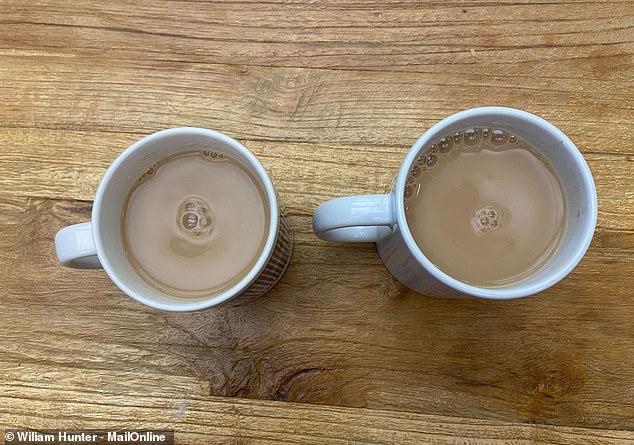
can you spot the difference? The cup on the right is brewed with hot milk in a hot mug, while the cup on the left is brewed in the normal way. The hot milk initially seemed to curdle slightly, but this disappeared after stirring
Now it was time for the final and most controversial step of Dr.’s recipe. Francl: adding salt.
While many of us may add sugar to our brew, Dr. Francl says it’s actually salt that is best for reducing the bitterness in the tea.
And here science is definitely on Dr.’s side. Francl.
Our tongues are covered with different taste receptors for different tastes.
Normally, the tannins in tea that are released when brewing activate the bitter receptors and tell our brain that we are tasting something unpleasant.
But when we add salt to food and drinks, sodium ions bind to salt receptors on our tongue and suppress our ability to taste bitterness.
A 1997 study even shows that salt selectively filters out unpleasant flavors, but allows us to discover tasty flavors such as sweetness.
This all sounds great, but does it really work?
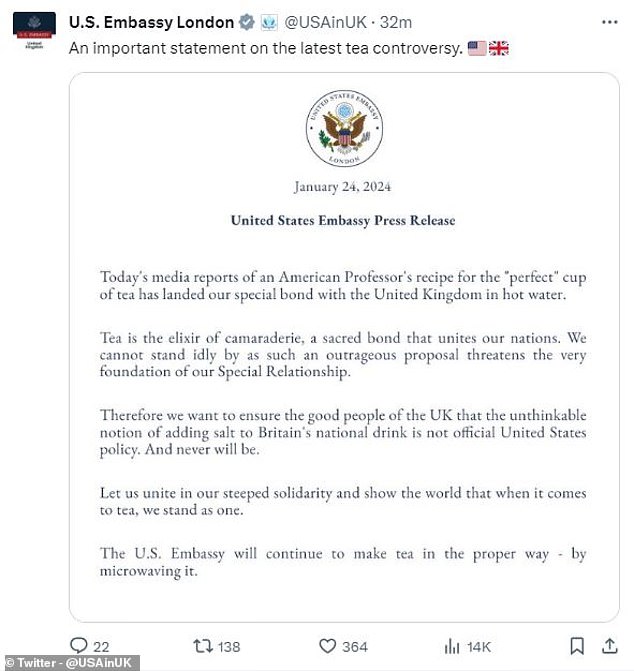
Dr.’s recipe Frankl for a ‘perfect’ cup of tea has proven so shocking that the US Embassy in London even joked on X (formerly Twitter) about the recipe
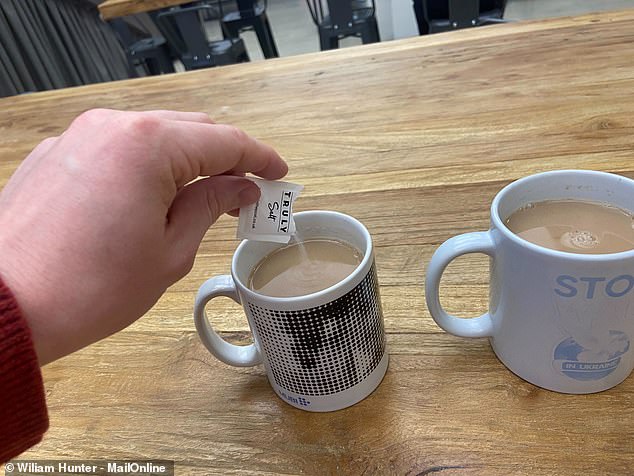
Breaking all the rules, we added a pinch of salt to the ‘perfect’ cup of (right) to see if it would really be less bitter. By comparison, the regular cup of tea (left) was left unseasoned
The short answer: absolutely not.
Before adding the salt, I would say there was a slight improvement in the ‘perfect’ tea compared to the control cup.
Maybe it was a psychological effect of all the extra effort, but the tea might have tasted a little richer.
This could also be a result of the temperature, as between the hot milk and the preheated mug, the perfect tea was still piping hot even after a few minutes.
But adding the salt was definitely a mistake.
I added a pinch of salt to the ‘perfect cuppa’ while leaving my control tea unadulterated.
MailOnline tested adding salt to our tea, as recommended by Dr. Francl. However, as you can see from these before and after images, the result was a rather unpleasant drink that was both scalding hot and strangely salty
The result was just a salty cup of incredibly hot tea that tasted awful.
Concerned that I had added too much salt to be a fair test, I added a small pinch to the control tea.
By gradually adding more salt, I found that the result was either a cup of tea that tasted much the same as before, or a disturbingly salty drink.
However, to give this theory the best chance of success, I decided to repeat the experiment with a few different types of tea.
I made a raspberry and pomegranate tea and an Earl Gray and added a small pinch of salt to each.
I had high hopes for the Earl Gray, as I thought it would be the closest to the loose-leaf teas recommended by Dr. Francl.
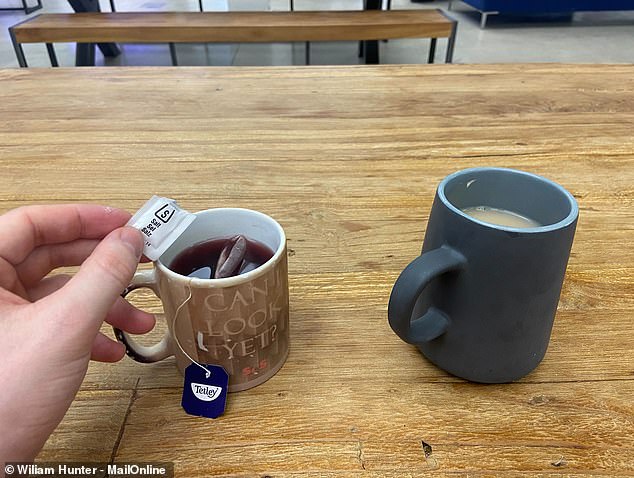
In the name of science, MailOnline tested Dr. Francl’s recommendation to add salt to our tea with a number of different types of tea. We added salt to both a cup of herbal fruit tea (left) and a cup of Earl Gray (right) to approximate the loose-leaf tea required
But if there was an improvement, it was so imperceptibly subtle that it escaped my tired taste buds.
Although not entirely unpleasant, the main effect was to make the tea slightly salty.
The fruit tea, on the other hand, was actually quite tasty.
Adding salt to the sweet tea created something that tasted like a hot electrolyte drink.
But whether that sounds appealing to you is probably a matter of personal taste.

Is this the perfect tea round? Adding salt to normal tea was unnoticeable or unpleasant, but adding a little spice to fruit tea actually turned out to be quite tasty
So, should you try this recipe the next time you take a tea round at the office?
Unless you have real grudges against your coworkers, I recommend you don’t try this recipe on them.
The hot mug and milk are nice, but it’s messy and takes forever to set up, especially in a cramped office kitchen.
Even after all the testing, the ‘perfect’ tea was still significantly hotter than the control, which could be ideal for someone who hates cold tea.
Meanwhile, adding salt is completely undetectable or very unpleasant.
Perhaps the effect is better with high-quality loose tea, but for people who use tea bags, this ‘perfect’ recipe will really not be for them.


